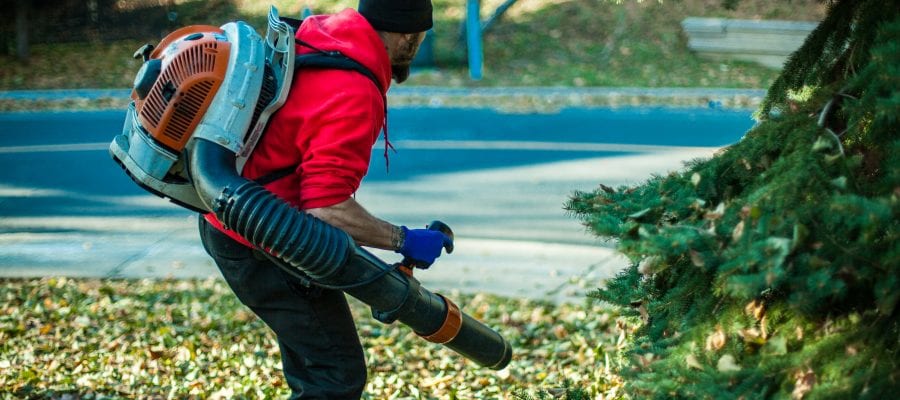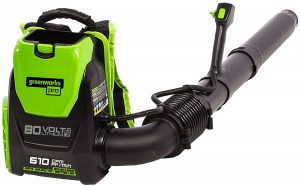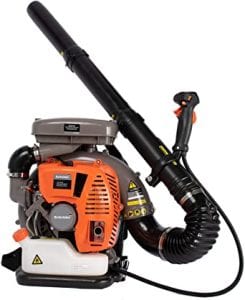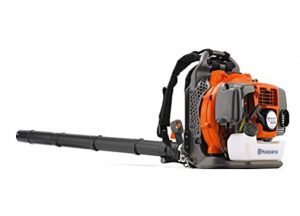The Best Backpack Leaf Blowers
We looked at the top 11 Backpack Blowers and dug through the reviews from 58 of the most popular review sites including and more. The result is a ranking of the best Backpack Blowers.

Our Review Process
Don't Waste Your Money is focused on helping you make the best purchasing decision. Our team of experts spends hundreds of hours analyzing, testing, and researching products so you don't have to. Learn more.
Our Picks For The Top Backpack Blowers
The Greenworks PRO 80V is an electric blower that doesn't sacrifice power for sustainability. With a maximum output of 610 CFM, it's sufficient for most debris. One of the most lightweight designs at 14 pounds (battery included), it also has a turbo button for extra speed.
Added Turbo ButtonIf speed is important to you, this Greenworks PRO 80V Cordless Backpack Blower delivers thanks to its bonus turbo button.
Sold start up performance is what you'll get with this industrial backpack blower. It's powerful enough to clear large wooded lots, which means clearing wet leaves and debris are no problem. Also included with your purchase is a handy carburetor adjustment tool.
Anti-Vibration SystemIf you're looking for a commercial-grade backpack blower to use on a job site, this model is an excellent choice.
This backpack blower's lightweight frame is augmented by a well-designed harness. The nozzle is easy to control, even with the impressive max output from the 50cc engine. X-Torq and other exhaust damping features also increase the fuel efficiency and reduce emissions.
Superior Lightweight DesignThis backpack blower's lightweight design makes it easy to use when you have multiple jobs on the schedule.
Buying Guide
The sight of auburn leaves on your lawn in the morning is a refreshing calling card of nature, reminding you that fall is here in all its multicolored splendor. It’s also a sign that you’ve got a hefty dose of yard work coming up.
If that yard is big enough and those leaves are plentiful enough, you’ll probably want to trade up from that lightweight handheld leaf blower. When you want a yard cleaned up quickly, there’s nothing like the power of a backpack blower. The heftiest ones can even handle more than one season of yardwork by blowing snow off your driveway or getting rid of branches and other light debris.
There can be a wide range of efficiency in backpack blowers, but the power source is one of the first things you’ll want to look at. And while electric blowers are an increasingly popular choice, gas-powered models still have plenty of upsides.
When it comes to electric blowers, you’ll find corded models at the lower end of the spectrum on price. It’s easy to see why, as these units not only leave you tethered to a power cord but generally supply less power. Cordless electric blowers won’t necessarily sacrifice any of that power for the convenience of free-roaming operation, but they may have less runtime depending on the battery.
Gas-powered blowers can be a little intimidating for those who haven’t handled them before, but the Big Bad Wolf has nothing on their strength. They operate on the same general type of internal combustion engine you have in your car (or more likely, your lawnmower), and those engines can be divided into a couple of types: 2-cycle and 4-cycle.
You might see them also referred to as 2-stroke or 4-stroke, but it means the same thing. Those numbers are the number of strokes (or cycles) needed to complete the process of combustion and exhaust that turns gasoline into energy. Without getting into the mechanical weeds, suffice to say that 2-stroke engines get that process done quicker and dirtier. It translates into an engine that’s not only light but powerful and cheaper to boot. On the downside, 2-stroke engines tend to be louder and less efficient, resulting in more pollution. Most engines of this type also require a precise mixture of oil and gas that goes into the same intake chamber, but you can usually buy this fuel pre-mixed.
On the other hand, 4-cycle engines are more like your car. The gas and oil are loaded into separate tanks. With more moving parts to deal with, these engines are heavier but more fuel-efficient, saving you money in the long run on gas. In either case, you can get a good measure of your engine’s output by checking the displacement volume. On the high side is 40 cc’s or more. Sometimes 4-cycle engines are easier on your body, too.
“While heavier than a 2-cycle, it operates at cooler temperatures,” says Vicki Liston, our home improvement expert and host of “On The Fly… DIY,” an award-winning show featuring helpful DIY project tutorials.
Electric or gas-powered, you’re going to want to know how powerful it is. Any backpack blower is liable to pack a lot more wind than a handheld model, but exactly how much is enough? You’ll see blowing power measured in two ways: MPH (miles per hour) and CFM (cubic feet per minute). MPH, of course, is a measure of wind speed, but that won’t mean much if there’s only a trickle of air coming out of the nozzle. CFM is a measure of volume, and it’s an equally important part of the equation. For backpack blowers, MPH might range from 100 to 300 or higher, while CFM varies from 300 to 700 or so.
“If you plan on blowing around heavier items like twigs, sticks and pebbles, look for a high CFA or MPH rating,” adds Liston.
Our Expert Consultant

Home Improvement Expert
Vicki Liston writes, produces, and narrates “On The Fly…DIY,” an award-winning home improvement and DIY show of unique project tutorials for the casual DIY’er.
Home improvement and all things DIY have been Liston’s passion since she bought her first house in 2007 and she started making video blogs in 2014. She’s performed hundreds of DIY projects, from small ones to major, wall-smashing renovations and can teach you how to make a trendy DIY barn door for cheap. The proceeds earned from “On The Fly…DIY” are donated to no-kill animal shelters and rescue organizations.
Why we recommend these backpack blowers?
Products Considered
Products Analyzed
Expert Reviews Included
User Opinions Analyzed
What to Look For
- If you’re already committed to getting a backpack blower, it’s easy to be swayed into getting the most powerful model for the cheapest price. But if you want to keep your neighbors on your good side, consider the efficiency. Backpack blowers can be extremely loud, and in a crowded community, that might greatly limit the time you can use it without making enemies. Be sure to check the decibel level on the blower before you buy. Gas models tend to be the noisiest, but there’s a lot of variation on that statistic.
- If you’re buying a cordless, electric powered blower, take a moment to read through the parts. It’s not a given that your battery will be included. They can cost a pretty penny, and that’s not even including the charger. Even so, you may still come in cheaper than the higher-end gas models. If your lawn is especially big, you may want to consider investing that extra dough in a second battery to swap into your blower when the first one runs out of juice.
- Weight is also a big consideration, particularly for older users. Electric backpack blowers might weigh 10 pounds or less, while gas blowers can top out at more than twice that for 4-cycle models. Their extra power might get the job done fast, but you can expect to tack on some extra minutes if it’s too unwieldy to use. Some of that can be mitigated with solid design that distributes the weight evenly.
- Accessories can be a huge plus, turning a simple leaf blower into a versatile cleaner. Many blowers come with at least one interchangeable nozzle. Flat tips are good for blowing a wide swath of loose leaves and debris, while rounded ones can help break up deeply embedded or wet leaves. Other handy add-ons include leaf bags to hold all that mess, or gutter kits.
- Your backpack blower’s vibrations might make leaf blowing painful. “Vibration can quickly cause fatigue and numbness and can turn the work into an extremely uncomfortable experience,” says Liston. Look for anti-vibration features to avoid this problem.
- You may be used to mowing the lawn in comfortable clothes, but leaf blowers require a little more caution. No matter how adept you are at using them, there will be loose debris flying around. Don’t forget to wear safety goggles and perhaps a breathing mask — and for long-term hearing protection, a pair of earbuds is a must.
- Depending on where you live, your leaf blower might only get used a couple of months out of the year. Don’t let that be the only time you turn it on. To ensure that your blower keeps operating at peak efficiency, run it once a month in a well-ventilated area.
You May Also Enjoy Our Other Reviews
- Robotic Vacuum
- Cordless Vacuums
- Air Mattress
- Drone
- Electric Razor
- Convertible Car Seat
- Infant Car Seat
- Dry Dog Food
- Carpet Cleaners
- Air Fryers
- Laptops
- Home Printers
- Wireless Router
- Streaming Device
- Electric Pressure Cooker
- Chromebook
- Television
- Digital Camera To Capture Special Moments On The Fly
- Smartwatch
- Upright Vacuum




